
At the panel, entitled “Advertising innovations: How are brands leveraging the power of online video marketing”, Chris Jaques, CEO of M&C Saatchi Asia, noted that 'Let’s make a viral video' is the most naive marketing statement to make, and that generating an emotional response is important to engage consumers.
"The most important driver for viral is emotional arousal, and positive videos will be shared four or five times more than the negative ones,” he said. “Another driver is content that creates physical reaction" such as laughing and crying.
The panel also included Oscar Prats, MD of Singapore at OgilvyOne Worldwide; Mark Liversidge, CMO at CSL; John Merrifield, CCO at Google Asia-Pacific; and Ted Mico, COO at Mirri Ad. The panel was moderated by Atifa Silk, Campaign Asia-Pacific editorial director.
Prats said the problem starts from brands and agencies thinking about creating viral campaigns from the inside. “It is not the lacking of idea, we are just not thinking from the consumers’ side,” he said. “Brands hate giving the control to consumers to build them and let them own the brands.”
Mico cited Red Bull as a brand that harnesses media well. "They give up the control," he said. "For example the space jump [by Felix Baumgartner in October last year]. They can easily kick out such an idea because of the high risk."
“We start asking the wrong question, so we get the wrong answer,” he added. “Brands should understand who they want to reach out to before they say they want to do a viral video.”
Liversidge said communities can provide brands the viral results they want to achieve. He noted that it is acceptable for brands to lose a bit of control in order to attract more audiences.
“Let the community take ownership of the brand which will drive long-lasting engagement,” he added.
Prats suggested that brands can find current events or issues in society and try to associate with them. The latest Dove effort, he said, is one strong example.
“It talks about something, not the brand,” he said. “It is long term and not only a spike.”
Merrifield said brands often have their own point of view and are reluctant to adjust it. “Once brands let go and adjust to reality and do without restrictions, there is potential,” he said.


.jpg&h=334&w=500&q=100&v=20250320&c=1)


.png&h=334&w=500&q=100&v=20250320&c=1)


.jpg&h=334&w=500&q=100&v=20250320&c=1)
.jpg&h=334&w=500&q=100&v=20250320&c=1)





.png&h=268&w=401&q=100&v=20250320&c=1)


.jpg&h=268&w=401&q=100&v=20250320&c=1)
